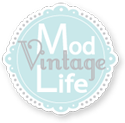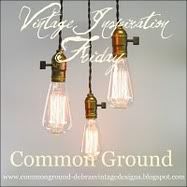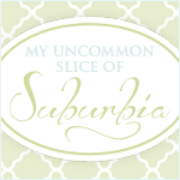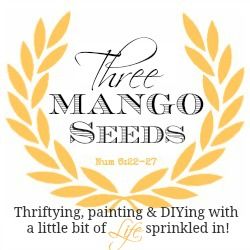The tops started out like this:
I know! I am crazy for wanting to do away with that!

And this is how they turned out with the leafing added. I would say that was a bit of an improvement, No?
These look much more expensive then they really were to make. The tables were free from the trash and the leafing cost me $15. (2 packages of silver leaf and one bottle of sizing for two tables).
If you look closely, I "dipped" the bottom of each leg in leafing as well. Just tape it off and paint your sizing on below. It adds a great detail to the legs.
Leafing is a very versatile craft supply. The leaf usually comes in package of 25 sheets that measure 5" x 5" and come in silver, bronze and gold leaf. It is different from Gilding in that gilding is painted on and leafing is applied over sizing. Sizing is actually a glue that dries tacky. So you need that too in order to leaf.
Okay enough with the school lesson, let's see how this is done. Decide what kind of leafing you want to apply. I choose silver for this project only because I like silver and wood together and I had a lot laying around.
Grab something you want to leaf. I got this pedestal bowl at the thrift store find for $2.00. Just wait for it's transformation in a few easy steps and about 15 minutes.
I first wanted the wood to look better so I applied my Restor-a-Finish all over it.
Now gather your supplies. There should be a 3 inch chip brush and a small paint brush in this photo but I forgot. Si-La-Vie.
And this is why you do not add Restor-a-Finish where you want to leaf. Oil and water do not mix. Totally forgot about that in my need to make everything look shiny.

A little sand paper will take that finish off (don't forget to wipe the dust away) and you can apply your sizing.
Very important! Anything caught in the sizing will show up under the leaf so make very sure that your surface is totally free of debris. If your piece has dings etc, fill them in with wood putty or something suitable and sand to a very fine finish and wipe clean. Your surface needs to be completely smooth for leafing to look good.
* Remember extra prep makes a beautiful piece look extraordinary
I did not want my edge to be leafed so I carefully painted the sizing on just to the lip of the bowl.
Rule #1 of leafing: wherever you paint the sizing, the leaf will surely follow so be careful and just take your time.
When it dries clear, you are ready to add your leaf sheets.
Plan out your project before adding your first sheet of leaf.
For something like this bowl, I start in the middle and then add around the edges. For my table, I marked off my center and did my first row of leafing down the center. Then I added the next row above and below it out to the edges. Otherwise you might have a full sheet on one end and a half-sheet on the other. Does not look well-thought out.
Think balance so that the subtle lines will look well-placed.
Gently pick up your first piece of leaf and gently lay it in the middle. There is a special brush you can buy to apply each sheet but I have had great success just using my hands and patience.
Take your chip brush and GENTLY rush over the leaf to adhere it to the sizing. It will tear at this point if you are too harsh.
This is what it looks like after using the brush. Stay with me. I know this is the ugly stage but it will get better and more professional looking in about a minute or two.
Take you second sheet and slightly overlap it with one edge of the first sheet. Using your brush, gently brush UP to the edge making sure that you do not let the top of the leaf touch the lip until it has been eased into place with the brush otherwise it will tear. Remember, once the leaf has touched sizing, it is stuck, that is why you need to keep it up until pressed into place with the brush.
Now you can gently pull away the remaining leaf. Save it and use it on the next corner if you have enough.
Always overlap your edges using the good edge, not a torn edge.
Leaf all four sides of the first square
Take any left over pieces and overlapping like before, add them in the corners. Use the "good" corner to overlap.
Okay, I know this still looks a little rough but now comes the fun part.
Some people use the chip brush to really brush the leaf into place now. I use it very firmly but gently but if you are not sure, just use your finger since you can scratch the leaf with the brush if you are too vigorous. Just rub your finger over the leaf, pressing firmly until the leaf looks very smooth and the extra bits are removed.
I used my thumb on the edge to remove the extras.
Throw the little bits out, keep larger bits for future projects. See my faux mercury lamp bases to see how I used leafing and large bits in a completely different manner
At this point, you can add a little stain to make it a warmer shade of silver if you like. I did not but you do need to seal the leaf regardless or it will eventually flake and peel. The easiest method I know is to use a wipe on poly and this you CAN add over the entire piece.
Let dry and enjoy!
Now that is a pretty nifty $2.00 bowl
Are you still scared to try leafing or will this inspire you to tackle a leaf with some leaf?
Always being renewed,






















































